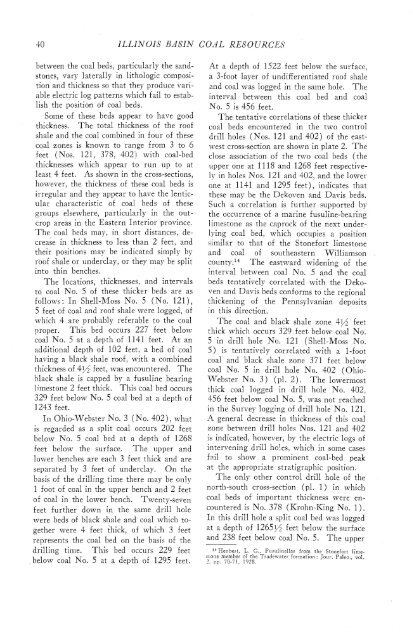subsurface geology and coal resources of the pennsylvanian system ...
subsurface geology and coal resources of the pennsylvanian system ...
subsurface geology and coal resources of the pennsylvanian system ...
You also want an ePaper? Increase the reach of your titles
YUMPU automatically turns print PDFs into web optimized ePapers that Google loves.
40 ILLINOIS BASIN COAL RESOURCES<br />
between <strong>the</strong> <strong>coal</strong> beds, ~articularly <strong>the</strong> s<strong>and</strong>stones,<br />
vary laterally in lithologic composition<br />
<strong>and</strong> thickness so that <strong>the</strong>y produce variable<br />
electric log patterns which fail to establish<br />
<strong>the</strong> position <strong>of</strong> <strong>coal</strong> beds.<br />
Some <strong>of</strong> <strong>the</strong>se beds appear to have good<br />
thickness. The total thickness <strong>of</strong> <strong>the</strong> ro<strong>of</strong><br />
shale <strong>and</strong> <strong>the</strong> <strong>coal</strong> combined in four <strong>of</strong> <strong>the</strong>se<br />
<strong>coal</strong> zones is known to range from 3 to 6<br />
feet (Nos. 121, 378, 402) with <strong>coal</strong>-bed<br />
thicknesses which appear to run up to at<br />
least 4 feet. As shown in <strong>the</strong> cross-sections,<br />
however, <strong>the</strong> thickness <strong>of</strong> <strong>the</strong>se <strong>coal</strong> beds is<br />
irregular <strong>and</strong> <strong>the</strong>y appear to have <strong>the</strong> lenticular<br />
characteristic <strong>of</strong> <strong>coal</strong> beds <strong>of</strong> <strong>the</strong>se<br />
groups elsewhere, particularly in <strong>the</strong> outcrop<br />
areas in <strong>the</strong> Eastern Interior province.<br />
The <strong>coal</strong> beds may, in short distances, decrease<br />
in thickness to less than 2 feet, <strong>and</strong><br />
<strong>the</strong>ir positions may be indicated simply by<br />
ro<strong>of</strong> shale or underclay, or <strong>the</strong>y may be split<br />
into thin benches.<br />
The locatio,ns, thicknesses, <strong>and</strong> intervals<br />
to <strong>coal</strong> No. 5 <strong>of</strong> <strong>the</strong>se thicker beds are as<br />
follows: In Shell-R4oss No. 5 (No. 121),<br />
5 feet <strong>of</strong> <strong>coal</strong> <strong>and</strong> ro<strong>of</strong> shale were logged, <strong>of</strong><br />
which 4 are probably referable to <strong>the</strong> <strong>coal</strong><br />
proper, This bed occurs 227 feet below<br />
<strong>coal</strong> No. 5 at a depth <strong>of</strong> 1141 feet. At an<br />
additional depth <strong>of</strong> 102 feet, a bed <strong>of</strong> <strong>coal</strong><br />
having a black shale ro<strong>of</strong>, with a combined<br />
thickness <strong>of</strong> 4?,4 feet, was encountered. The<br />
black shale is capped by a fusuline bearing<br />
limestone 2 feet thick. This <strong>coal</strong> bed occurs<br />
329 feet below No. 5 <strong>coal</strong> bed at a depth <strong>of</strong><br />
1243 feet.<br />
In Ohio-Webster No. 3 (No. 402), what<br />
is regarded as a split <strong>coal</strong> occurs 202 feet<br />
below No. 5 <strong>coal</strong> bed at a depth <strong>of</strong> 1268<br />
feet below <strong>the</strong> surface. The upper <strong>and</strong><br />
lower benches are each 3 feet thick <strong>and</strong> are<br />
separated by 3 feet <strong>of</strong> underclay. On <strong>the</strong><br />
basis <strong>of</strong> <strong>the</strong> drilling time <strong>the</strong>se may be only<br />
1 foot <strong>of</strong> <strong>coal</strong> in <strong>the</strong> upper bench <strong>and</strong> 2 feet<br />
<strong>of</strong> <strong>coal</strong> in <strong>the</strong> lower bench. Twenty-seven<br />
feet fur<strong>the</strong>r down in <strong>the</strong> same drill hole<br />
were beds <strong>of</strong> black shale <strong>and</strong> <strong>coal</strong> which toge<strong>the</strong>r<br />
were 4 feet thick, <strong>of</strong> which 3 feet<br />
represents <strong>the</strong> <strong>coal</strong> bed on <strong>the</strong> basis <strong>of</strong> <strong>the</strong><br />
drilling time. This bed occurs 229 feet<br />
belo,w <strong>coal</strong> No. 5 at a depth <strong>of</strong> 1295 feet.<br />
At a depth <strong>of</strong> 1522 feet below <strong>the</strong> surface,<br />
a 3-foot layer <strong>of</strong> undifferentiated ro<strong>of</strong> shale<br />
2nd <strong>coal</strong> was logged in <strong>the</strong> same hole. The<br />
interval between this <strong>coal</strong> bed <strong>and</strong> <strong>coal</strong><br />
No. 5 is 456 feet.<br />
The tentative correlations <strong>of</strong> <strong>the</strong>se thicker<br />
<strong>coal</strong> beds encountered in <strong>the</strong> two control<br />
drill holes (Nos. 121 <strong>and</strong> 402) <strong>of</strong> <strong>the</strong> eastwest<br />
cross-section are shown in plate 2. The<br />
close association <strong>of</strong> <strong>the</strong> two <strong>coal</strong> beds (<strong>the</strong><br />
upper one at 1118 <strong>and</strong> 1268 feet respectively<br />
in holes Nos. 121 <strong>and</strong> 402, <strong>and</strong> <strong>the</strong> lower<br />
one at 1141 <strong>and</strong> 1295 feet), indicates that<br />
<strong>the</strong>se may be <strong>the</strong> Dekoven <strong>and</strong> Davis beds.<br />
Such a correlation is fur<strong>the</strong>r supported by<br />
<strong>the</strong> occurrence <strong>of</strong> a marine fusuline-bearing<br />
limestone as <strong>the</strong> caprock <strong>of</strong> <strong>the</strong> next underlying<br />
<strong>coal</strong> bed, which occupies a position<br />
similar to that <strong>of</strong> <strong>the</strong> Stonefort limestone<br />
<strong>and</strong> <strong>coal</strong> <strong>of</strong> sou<strong>the</strong>astern Williamson<br />
county.'" The eastward widening <strong>of</strong> <strong>the</strong><br />
interval between <strong>coal</strong> No. 5 <strong>and</strong> <strong>the</strong> <strong>coal</strong><br />
beds tentatively correlated with <strong>the</strong> Dekoven<br />
<strong>and</strong> Davis beds conforms to <strong>the</strong> regional<br />
thickening <strong>of</strong> <strong>the</strong> Pennsylvanian deposits<br />
in this direction.<br />
The <strong>coal</strong> <strong>and</strong> black shale zone 4fi feet<br />
thick which occurs 329 feet below <strong>coal</strong> No.<br />
5 in drill hole No. 121 (Shell-Moss No.<br />
5) is tentatively correlated with a I-foot<br />
<strong>coal</strong> <strong>and</strong> black shale zone 371 feet below<br />
<strong>coal</strong> No. 5 in drill hole No. 402 (Ohio-<br />
IVebster No. 3) (pl. 2). The lowermost<br />
thick <strong>coal</strong> logged in drill hole No. 402,<br />
456 feet below <strong>coal</strong> No. 5, was not reached<br />
in <strong>the</strong> Survey logging <strong>of</strong> drill hole No. 121.<br />
A general decrease in thickness <strong>of</strong> this <strong>coal</strong><br />
zone between drill holes Nos. 121 <strong>and</strong> 402<br />
is indicated, however, by <strong>the</strong> electric logs <strong>of</strong><br />
-<br />
intervening drill holes, which in some cases<br />
fail to show a prominent <strong>coal</strong>-bed peak<br />
at <strong>the</strong> appropriate stratigraphic position.<br />
The only o<strong>the</strong>r control drill hole <strong>of</strong> <strong>the</strong><br />
north-south cross-section ( pl. I ) in which<br />
<strong>coal</strong> beds <strong>of</strong> important thickness were encountered<br />
is No. 375 (Krohn-King No. I),<br />
In this drill hole a split <strong>coal</strong> bed was logged<br />
at a depth <strong>of</strong> 1265g feet below <strong>the</strong> surface<br />
<strong>and</strong> 238 feet below <strong>coal</strong> No. 5. The upper<br />
14Henbest, L. G., Fuaulinellas from <strong>the</strong> Stonefort limestone<br />
member <strong>of</strong> tlic Tradewater formation: Jour. Paleo., vol.<br />
2. pp. 70-71, 1928.
















